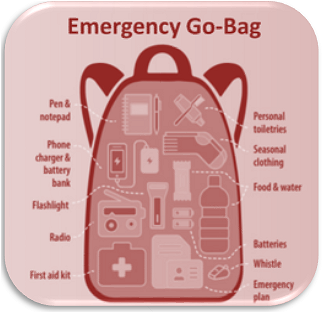In addition to your Family Emergency Kit, you should also have an "Emergency Go-Bag".
What is an Emergency Go-Bag?
An emergency Go Bag contains your personal emergency supplies pre-packed in an easy-to-carry solution, usually a sturdy backpack. It holds all the items you will need if you have to leave your home or workplace immediately; for example, if you are advised to evacuate. In addition to essential survival supplies you should pack personal items such as medication, maps, keys, spare glasses, copies of documents, cash and other important records. Store your Go Bag in a safe and secure location ready to be grabbed at a moment's notice.

You may need to leave immediately in the event of an emergency, such as a Flood or a Fire. Be ready to go by having a smaller version of your emergency kit in an easy-to-access place in your home. In addition to having one at home, create grab-and-go bags for your workplace and vehicles that contain:
- Food (ready to eat) and water
- Phone charger and battery bank
- Small battery-powered or hand-crank radio
- Battery-powered or hand-crank flashlight
- Extra batteries
- Small first-aid kit and personal medications
- Personal toiletries and items, such as an extra pair of glasses or contact lenses
- Copy of your emergency plan, copies of important documents, such as insurance papers
- Cash in small bills
- Local map with your family meeting place identified
- Seasonal clothing and an emergency blanket
- Pen and notepad
- Whistle